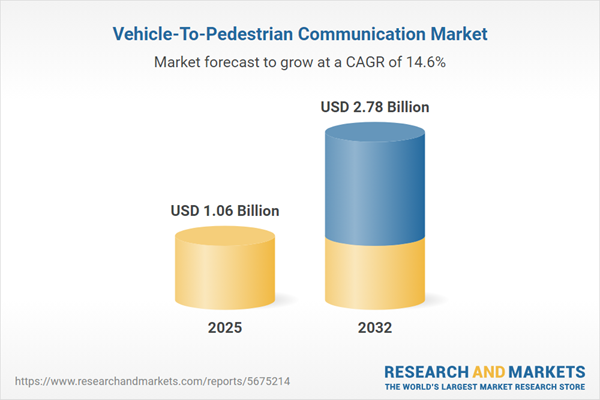Speak directly to the analyst to clarify any post sales queries you may have.
Vehicle-to-pedestrian communication is rapidly emerging as a cornerstone of future urban mobility, enabling safer streets and more responsive transport networks by weaving together digital infrastructure and city planning. Senior decision-makers are uniquely positioned to shape the next era of connected mobility through strategic investment and cross-sector collaboration.
Market Snapshot: Vehicle-to-Pedestrian Communication Market Size and Growth
The global vehicle-to-pedestrian communication market is demonstrating strong momentum as smart city initiatives gain precedence. In 2024, the market is valued at USD 932.75 million and is expected to reach USD 1.06 billion in 2025. Projections indicate significant growth to USD 2.78 billion by 2032, equating to a compound annual growth rate (CAGR) of 14.63%. Heightened investments in urban infrastructure, smart city projects, and advanced communication platforms are driving this expansion. Continued digitalization of urban transit and commitment to integrating seamless, interoperable systems between public authorities and private sector partners fuel sustained market opportunity.
Scope & Segmentation of the Vehicle-to-Pedestrian Communication Market
- Communication Technologies: Bluetooth, Cellular V2X, Dedicated Short-Range Communication, and adaptive Wi-Fi establish secure, real-time data links suitable for varied urban situations. These technologies enable vehicles and pedestrians to interact seamlessly, even in complex, high-traffic environments.
- Component Types: Onboard vehicle modules—available for both new and retrofit installations—plus smartphone and wearable device compatibility, cater to a diverse set of urban users and allow easy upgrades as needs evolve.
- Deployment Models: Direct peer-to-peer connections and system-wide networks support both targeted pilot initiatives and expansive city-wide implementations, adapting to infrastructure readiness and policy landscapes.
- Network Types: Ad-hoc networks provide flexibility for immediate, local deployment, while dedicated networks support integrated, municipality-wide communication systems that enhance operational reliability.
- Pedestrian Device Types: Mobile devices and wearable technology streamline prompt notifications and facilitate intuitive vehicle-pedestrian interaction, broadening adoption among urban populations, including vulnerable road users.
- Applications: Solutions address key urban needs, enabling applications such as collision prevention, emergency notifications, navigation assistance, and specialized services for at-risk populations, strengthening urban safety measures.
- End Users: Core stakeholders include automotive manufacturers, municipal bodies, logistics operators, and agencies prioritizing pedestrian safety, all leveraging these solutions to improve network resilience and operational outcomes.
- Regional Coverage: Markets in North America, Latin America, Europe, Middle East and Africa, and Asia-Pacific each confront distinctive regulatory, technological, and digital infrastructure variables, shaping the evolution and timing of deployment strategies.
- Leading Companies: Key industry players such as Qualcomm Incorporated, NXP Semiconductors N.V., Continental AG, Robert Bosch GmbH, Denso Corporation, Huawei Technologies Co., Ltd., ZTE Corporation, Kapsch TrafficCom AG, STMicroelectronics N.V., and Texas Instruments Incorporated are strengthening the market landscape with advanced offerings and innovation capacity.
Key Takeaways for Decision Makers
- Collaboration among automotive, municipal, and technology sectors is essential for standardized, scalable solutions across increasingly complex transportation networks.
- Efficient, low-latency data delivery between vehicles and pedestrians supports proactive urban safety, minimizing risks in dynamic traffic conditions.
- Dual deployment approaches—supporting both new installations and retrofits—provide organizational flexibility and protect infrastructure investments as technologies mature.
- Customization of deployments according to regulatory, geographic, and infrastructure factors can accelerate adoption and reduce technological barriers for cities of different sizes.
- End-to-end system interoperability ensures that data from vehicles, telecom infrastructure, and personal devices translates to actionable urban mobility insights, supporting data-driven decision-making for city stakeholders.
Tariff Impact: Navigating Supply Chain and Cost Dynamics
Forthcoming U.S. tariff measures are compelling companies to reevaluate supply chain management. Strategic shifts include increasing regional sourcing and deepening partnerships with local manufacturers to mitigate cost uncertainty and maintain stable technology delivery. For executives, this evolving environment highlights the need for agile sourcing policies and responsive procurement frameworks to ensure supply continuity and competitive performance in changing regulatory conditions.
Methodology & Data Sources
This report synthesizes insights from industry leaders, technology providers, and regulatory consultants. All data points, forecasts, and strategic assessments are thoroughly validated against recognized market sources, supporting robust decision-making for executive and investment teams.
Why This Report Matters
- Supports senior leaders as they shape investment, respond to regulatory and technology shifts, and align strategies with urban mobility transformation goals.
- Provides clear, actionable analysis of evolving trends, empowering organizations to proactively meet smart city expectations and integrate new connectivity standards.
- Frames supply chain and regulatory shifts to enable informed choices in market entry planning, risk evaluation, and sustainable expansion initiatives.
Conclusion
Vehicle-to-pedestrian communication is enabling safer, smarter urban mobility by connecting people and infrastructure. This report equips executive teams with insights to guide sustainable development, digital innovation, and effective urban growth strategies.
Additional Product Information:
- Purchase of this report includes 1 year online access with quarterly updates.
- This report can be updated on request. Please contact our Customer Experience team using the Ask a Question widget on our website.
Table of Contents
3. Executive Summary
4. Market Overview
7. Cumulative Impact of Artificial Intelligence 2025
Companies Mentioned
The companies profiled in this Vehicle-To-Pedestrian Communication market report include:- Qualcomm Incorporated
- NXP Semiconductors N.V.
- Continental AG
- Robert Bosch GmbH
- Denso Corporation
- Huawei Technologies Co., Ltd.
- ZTE Corporation
- Kapsch TrafficCom AG
- STMicroelectronics N.V.
- Texas Instruments Incorporated
Table Information
| Report Attribute | Details |
|---|---|
| No. of Pages | 195 |
| Published | October 2025 |
| Forecast Period | 2025 - 2032 |
| Estimated Market Value ( USD | $ 1.06 Billion |
| Forecasted Market Value ( USD | $ 2.78 Billion |
| Compound Annual Growth Rate | 14.6% |
| Regions Covered | Global |
| No. of Companies Mentioned | 11 |









